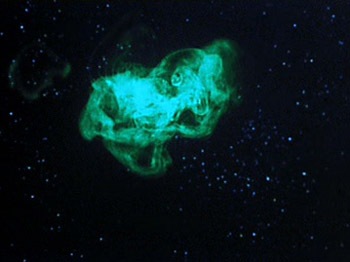Difference between revisions of "Murasaki 312 (FASA)"
(Created page with "{{MyriadMurasaki312}} {{ImageInfoBox2|name=Murasaki 312|file=murasaki_312-tos13_original.jpg|caption=Murasaki 312 (TOS 13)}}...") |
m |
||
| Line 5: | Line 5: | ||
{{TableRow|title=Advertising|data={{AmazonLinkTOSBD}}}} | {{TableRow|title=Advertising|data={{AmazonLinkTOSBD}}}} | ||
|}</div> | |}</div> | ||
| + | {{BannerFASA}} | ||
The Murasaki objects, first observed in the early 21st century, were [[quasar]]-like phenomena that were thought to be rarified gas clouds illuminated by [[synchotron radiation]].<ref name="Maps"/> Murasaki 312 was first explored in [[2207 (FASA)|2207]] by the [[U.S.S. Enterprise NCC-1701 (FASA)|U.S.S. ''Enterprise'' NCC-1701]]. A [[Shuttlecraft Galileo NCC-1701/7 (FASA)|shuttle]] with a science team aboard, sent to study the so-called "Murasaki Effect," was forced to crash-land on [[Taurus II (FASA)|Taurus II]], a planet in one of the several [[Taurus system (FASA)|star systems]] within the phenomenon, by unexpected interference with the shuttle's systems caused by the nebula's [[radiation (FASA)|radiation]],<ref name="TOS13"/> which peaked at unpredictable intervals, the most intense of which was at a wavelength of 485[[nanometer|nm]].<ref name="Maps"/> There, they discovered a hostile, [[Taureans (FASA)|indigenous hominid population]], and only escaped the planet after suffering heavy losses.<ref name="TOS13"/> Murasaki phenomena were noted to have a Warning of W-176: the phenomena were known to interfere with the electronic [[sensors (FASA)|sensor]] and guidance equipment of nearby spacecraft, with the peak effect lasting as long as twenty-four [[hours]].<ref name="Maps"/> | The Murasaki objects, first observed in the early 21st century, were [[quasar]]-like phenomena that were thought to be rarified gas clouds illuminated by [[synchotron radiation]].<ref name="Maps"/> Murasaki 312 was first explored in [[2207 (FASA)|2207]] by the [[U.S.S. Enterprise NCC-1701 (FASA)|U.S.S. ''Enterprise'' NCC-1701]]. A [[Shuttlecraft Galileo NCC-1701/7 (FASA)|shuttle]] with a science team aboard, sent to study the so-called "Murasaki Effect," was forced to crash-land on [[Taurus II (FASA)|Taurus II]], a planet in one of the several [[Taurus system (FASA)|star systems]] within the phenomenon, by unexpected interference with the shuttle's systems caused by the nebula's [[radiation (FASA)|radiation]],<ref name="TOS13"/> which peaked at unpredictable intervals, the most intense of which was at a wavelength of 485[[nanometer|nm]].<ref name="Maps"/> There, they discovered a hostile, [[Taureans (FASA)|indigenous hominid population]], and only escaped the planet after suffering heavy losses.<ref name="TOS13"/> Murasaki phenomena were noted to have a Warning of W-176: the phenomena were known to interfere with the electronic [[sensors (FASA)|sensor]] and guidance equipment of nearby spacecraft, with the peak effect lasting as long as twenty-four [[hours]].<ref name="Maps"/> | ||
{{References}} | {{References}} | ||
Latest revision as of 06:03, 5 February 2022
| Coordinates | -66.5, 47.4, 8.1 |
| First Appearance | TOS 13 (5 Jan 1967) |
| Advertising |
The Murasaki objects, first observed in the early 21st century, were quasar-like phenomena that were thought to be rarified gas clouds illuminated by synchotron radiation.[1] Murasaki 312 was first explored in 2207 by the U.S.S. Enterprise NCC-1701. A shuttle with a science team aboard, sent to study the so-called "Murasaki Effect," was forced to crash-land on Taurus II, a planet in one of the several star systems within the phenomenon, by unexpected interference with the shuttle's systems caused by the nebula's radiation,[2] which peaked at unpredictable intervals, the most intense of which was at a wavelength of 485nm.[1] There, they discovered a hostile, indigenous hominid population, and only escaped the planet after suffering heavy losses.[2] Murasaki phenomena were noted to have a Warning of W-176: the phenomena were known to interfere with the electronic sensor and guidance equipment of nearby spacecraft, with the peak effect lasting as long as twenty-four hours.[1]
Notes and References
- ↑ 1.0 1.1 1.2 Maynard, Jeff (Author). Star Trek Maps. Star Trek. Book. Bantam Books. August 1980.
- ↑ 2.0 2.1 Roddenberry, Gene (Executive Producer). "The Conscience of the King." Star Trek, Season 1, Episode 13 (Production 13). Directed by Gerd Oswald. Written by Barry Trivers. Desilu Productions, 8 December 1966.

